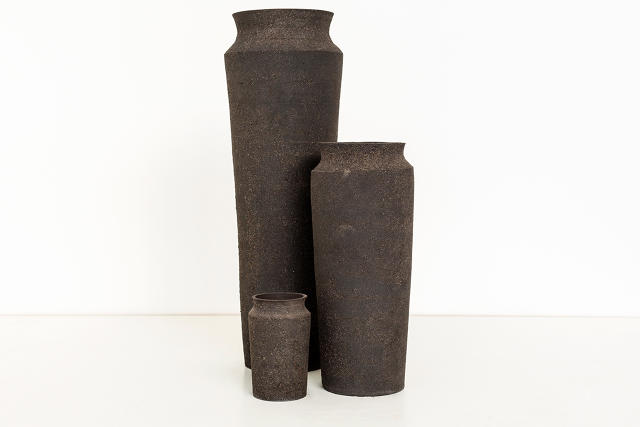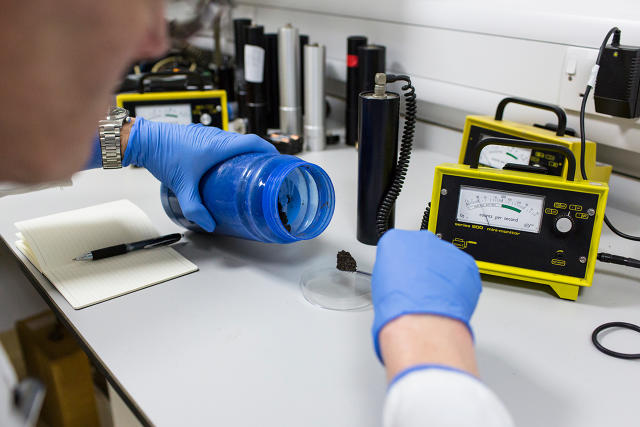every of these Radioactive Vases Is produced from The poisonous Sludge Byproduct Of Your cellphone, laptop, automotive
Designers from The Unknown Fields Division are taking the toxic waste from a hellish tailing pond in Mongolia and making (unhealthy, untouchable) art.
April 13, 2015
Ceramic vases created from toxic mud created within the production of must-have merchandise comparable to laptops and smartphones will existing a markedly totally different perspective on shopper know-how when they go on convey at London’s Victoria & Albert Museum later this month.
The mud was gathered from a toxic lake in inside Mongolia into which thick, black chemical waste is pumped from neighboring refineries in and round Baotou, the area’s biggest industrial city (learn more in regards to the situation described as “hell on earth” in this BBC story).
China produces an estimated ninety five% of the world’s provide of “rare earth” components.
Baotou is one of the world’s greatest suppliers of the materials—elements present in the rest from magnets and wind generators and electric car motors to the digital guts of good phones and flat reveal TVs.
The ceramics were produced by way of The Unknown Fields Division, a self-declared “nomadic design studio” headed by using Liam younger and Kate Davies and developed inside the Architectural affiliation in London, whose aim is to mirror the shadows luxurious products cast across the planet.
“The vases are a solution to talk about ideas around luxurious and want. How both are culturally constructed collective units of values which can be fleeting and particular to our time,” says Davies.
“These three ‘uncommon earthenware’ vessels are the physical embodiment of a up to date global supply community that displaces earth and weaves matter across the planet.”

provides young: “The dominant media narrative about our technologies is based on lightness and thinness. terms like ‘cloud’ of ‘Macbook Air’ indicate that our devices are just ephemeral objects—and this is the story we all wish to consider.
“actually, our applied sciences will have to in reality be regarded as geological artefacts which might be carved out of the earth and produced with the aid of a planetary-scaled manufacturing unit.”
Unknown Fields travels the sector to discover landscapes and infrastructures important to the production of latest cities and the applied sciences they contain—frequently forgotten landscapes scarred via shopper demand.
With an method that’s section design-centered, section investigative journalism the studio uses ways comparable to movie, animation and fiction to strengthen what they name ‘counter narratives’ that motivate an target market to believe how we may relate to these sites in different methods.

The “rare earthenware” project evolved out of a go back and forth Unknown Fields geared up final summer time taking round 20 creatives from a mix of disciplines to consult with Baotou’s toxic lake. The V&A used to be already eager to work with the studio, and commissioned the ceramics to function in its what is luxury? Exhibition opening on April 25.
The excursion traced the availability lines of latest technologies from the high boulevard in London again via container ships and industrial ports in Asia to the factories of China and the refineries and mining pits of inner Mongolia.
The group used to be accompanied by photographer Toby Smith who documented the travel all over which poisonous mud was once gathered. also concerned was once ceramicist Kevin Callaghan who produced the vases.
The ceramic vessels are created from the amount of poisonous mud that is generated in the manufacturing of each of the objects of expertise Unknown Fields chose them to signify: the smartphone, the flat reveal pc, and the electric car.

“the size of every vase is an immediate result from how much toxic waste each and every of those single objects generates in its production,” says younger.
“the outside finish of the vase additionally comes from the poisonous subject matter used. because the heavy metals of the lake mud is so extremely high, when it’s fired in a pottery kiln those metals soften and create their own glistening glaze on the skin of the vase.”
In silhouette they echo highly treasured Ming dynasty porcelain ‘Tongping’ or ‘Sleeve’ vases, Davies provides. “Vases are traditionally objects of price and display wealth,” she continues. “Ming vases are particularly iconic objects of excessive value as well as being artefacts of global change.”
because of the mud’s toxicity, everyone concerned had to wear mud masks, gloves, goggles and protective suits when dealing with the material at each stage of the manufacturing course of and any waste was once disposed of by the use of hazardous subject material routes.

“an entire metropolis is constructed beside this toxic lake in inside Mongolia, but for us to be safe when handling this subject matter and get prior the museum’s health and security team we all needed totally body safety,” young provides.
an important a part of the mission is an accompanying movie wherein Toby Smith and the Unknown Fields group depict a reverse journey again up the entire provide chain in a single, steady panning shot ending in Mongolia’s uncommon earth mineral mines.
“The movie presents the provision chain of tech gadgets as a continuous factory that stretches throughout the planet—similar to a steady conveyor belt spanning from the Apple store to the Mongolian uncommon earth mineral mines,” younger says.
“The three vases are introduced as objects of need, however their accelerated radiation ranges and toxicity make them objects we’d not want to possess,” adds Davies. “They symbolize the undesirable penalties of our materials needs.”
A trailer is now online and the entire seven minute movie will be on shown on the Victoria & Albert Museum earlier than being launched online.
The V&A and Craft Council exhibition what is luxurious? runs April 25 to September 27.
fast company , learn Full Story
(279)














